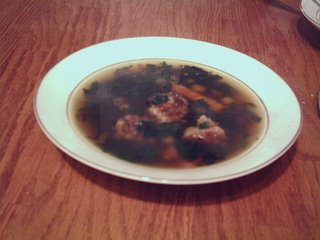 Around this time of the year, Christmas well-wishes are usually followed up with “Uh, do you celebrate Christmas?” I guess I do, although this is not at all common in Russian-Jewish immigrant families. New Year's--a Soviet-ized Christmas, really--is the big holiday for Russians, but Christmas itself is generally ignored. As for Hanukkah, few Russian Jews celebrate it in earnest. This holiday is usually commemorated by saying “Hey, it’s Hanukkah!” on the second of the eight days and then forgetting about the whole thing.
Around this time of the year, Christmas well-wishes are usually followed up with “Uh, do you celebrate Christmas?” I guess I do, although this is not at all common in Russian-Jewish immigrant families. New Year's--a Soviet-ized Christmas, really--is the big holiday for Russians, but Christmas itself is generally ignored. As for Hanukkah, few Russian Jews celebrate it in earnest. This holiday is usually commemorated by saying “Hey, it’s Hanukkah!” on the second of the eight days and then forgetting about the whole thing.My parents and I, though, are accidental non-conformists: ever since we came to the U.S., we happened to receive annual Christmas dinner invitations by our respective American friends. Add to that my childhood yearnings for an American Christmas, and you get holiday revelry chez Yulinka: a tree that stays up mid-December through early January; a festive dinner and gifts on Dec. 25, and a classic Russian appetizer and vodka spread on Dec. 31. And so it was this year.
St. Nick looked over a very American dinner of stuffed pork loin and roasted butternut squash...
 ... while an Old World babushka made sure that homemade sauerkraut, picked tomatoes and herring in a fur coat made an appearance on the table.
... while an Old World babushka made sure that homemade sauerkraut, picked tomatoes and herring in a fur coat made an appearance on the table.  Herring in a coat (seledka pod shuboi), the Russian version of seven-layer salad, is usually made for New Year’s, but it’s often served at festive dinners year-round. A layer of herring is covered with beets, potatoes and eggs, dressed with mayo, and topped with herbs, onions and sometimes olives. Every family has its own recipe, but I think my mom’s has a leg up thanks to a layer of tart apple that gives this rich appetizer a nice kick.
Herring in a coat (seledka pod shuboi), the Russian version of seven-layer salad, is usually made for New Year’s, but it’s often served at festive dinners year-round. A layer of herring is covered with beets, potatoes and eggs, dressed with mayo, and topped with herbs, onions and sometimes olives. Every family has its own recipe, but I think my mom’s has a leg up thanks to a layer of tart apple that gives this rich appetizer a nice kick.Method: Herring in a fur coat is best when made 12-24 hours before serving and left to “marinate” in the fridge.
You will need:
-1 smoked/salted herring fillet (about 1 lb, sold prepackaged at Russian stores; not pickled herring)
-2 small cooked, cooled and peeled potatoes and 1 large, cooked beet. Bring water to a boil in a sauce pan, add the beet and the potatoes, turn the heat to a simmer and cook until you can easily poke the vegetables through with a knife. The potatoes will take about 30 minutes; the beets, 1-1.5 hours.
-2 large, hardboiled eggs
-1 small, peeled Granny Smith apple (or another tart variety)
-1/2 small red onion, minced, plus a few thinly sliced pieces
-2 tbs. each chopped scallions, parsley and/or dill
Dressing:
In a small bowl, combine 1/4 cup mayo, 1/4 cup sour cream (or thick Greek yogurt), a dash of salt and pepper, and a splash of vinegar.
Cut the herring into small pieces (about 1/8-inch) and spread evenly on a big, round plate or serving dish. Dice the potatoes and spread over the herring. Sprinkle with some finely chopped red onion.
Spread about 3-4 tablespoons of dressing over the potatoes and herring. Grate the apple over the potato layer, and spread 3-4 tablespoons of dressing on top. Sprinkle with finely chopped red onion.
Grate the beet and the eggs over the apple layer. Top with the remaining dressing (make more as needed) and chopped scallions, parsley, dill, and thinly sliced onions. To serve, use a butter knife to slice and transfer to individual plates with a spatula.
You will need:
-1 smoked/salted herring fillet (about 1 lb, sold prepackaged at Russian stores; not pickled herring)
-2 small cooked, cooled and peeled potatoes and 1 large, cooked beet. Bring water to a boil in a sauce pan, add the beet and the potatoes, turn the heat to a simmer and cook until you can easily poke the vegetables through with a knife. The potatoes will take about 30 minutes; the beets, 1-1.5 hours.
-2 large, hardboiled eggs
-1 small, peeled Granny Smith apple (or another tart variety)
-1/2 small red onion, minced, plus a few thinly sliced pieces
-2 tbs. each chopped scallions, parsley and/or dill
Dressing:
In a small bowl, combine 1/4 cup mayo, 1/4 cup sour cream (or thick Greek yogurt), a dash of salt and pepper, and a splash of vinegar.
Cut the herring into small pieces (about 1/8-inch) and spread evenly on a big, round plate or serving dish. Dice the potatoes and spread over the herring. Sprinkle with some finely chopped red onion.
Spread about 3-4 tablespoons of dressing over the potatoes and herring. Grate the apple over the potato layer, and spread 3-4 tablespoons of dressing on top. Sprinkle with finely chopped red onion.
Grate the beet and the eggs over the apple layer. Top with the remaining dressing (make more as needed) and chopped scallions, parsley, dill, and thinly sliced onions. To serve, use a butter knife to slice and transfer to individual plates with a spatula.







 My mom and I cut the fish into sections, removed the skin and bones, and dug in. You can eat smocked mackerel spread on rye bread, with slices of cucumber and tomato. Or you can pick up the soft, fatty chunks with your fingers and pop them in your mouth, letting the fish melt on your tongue.
My mom and I cut the fish into sections, removed the skin and bones, and dug in. You can eat smocked mackerel spread on rye bread, with slices of cucumber and tomato. Or you can pick up the soft, fatty chunks with your fingers and pop them in your mouth, letting the fish melt on your tongue.


























